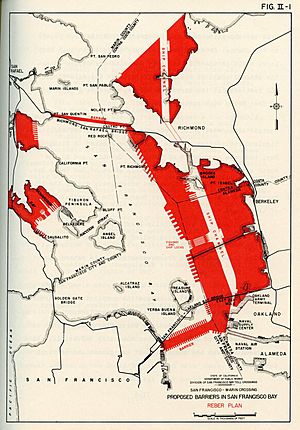Reber Plan facts for kids
The Reber Plan was a big idea from the late 1940s. It suggested filling in parts of the San Francisco Bay in California. The plan was created by John Reber, who was an actor, a theater producer, and a schoolteacher.
The San Francisco Bay Project Idea
This plan was also known as the San Francisco Bay Project. It aimed to change how the Sacramento River flowed into the bay from Suisun Bay. The idea was to build dams and channels to guide the river. This would create two huge freshwater lakes inside the bay.
These new lakes would provide fresh water for drinking and for watering crops. This water would help people and farmers living in the Bay Area. The plan also included building barriers that could support train tracks and highways. These would connect different parts of the Bay Area.
Between the two proposed lakes, John Reber wanted to create about 20,000 acres (81 square kilometers) of new land. A freshwater channel would run through this new land. On the western side of this channel, there would be airports and a naval base. There would also be two large locks, similar to those used in the Panama Canal. Factories and industrial areas would be built on the eastern side.
The San Francisco Chronicle newspaper supported the idea of a new road or bridge. They thought it could replace or add to the San Francisco–Oakland Bay Bridge. They wrote that even though there would be many challenges, they could be overcome. They believed the same effort and skill used for the Bay and Golden Gate bridges could make this plan happen.
Testing the Plan's Possibility
In 1953, the U.S. Army Corps of Engineers decided to study the Reber Plan more closely. They even built a large model of the Bay Area to test how the plan would work.
However, the main part of the plan – the barriers – did not pass this detailed study. The Reber Plan was finally dropped in the early 1960s. This marked a shift away from huge construction projects that completely changed nature. It also showed the beginning of a new focus on protecting the environment.


